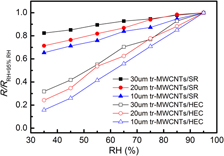Article contents
Research on highly sensitive humidity sensor based on Tr-MWCNT/HEC composite films
Published online by Cambridge University Press: 17 November 2014
Abstract

This study demonstrates a highly sensitive humidity sensor based on treated multiwalled carbon nanotube (tr-MWCNT) and hydroxyethyl cellulose (HEC) composite films. Tr-MWCNTs are obtained by mixed acid treatment to enhance their hydrophilicity and improve their dispersion in distilled water. Compared to tr-MWCNT/silicone rubber (SR) composite film, the humidity sensitivity of tr-MWCNT/HEC film is much higher than tr-MWCNT/SR film with the same film thickness. The humidity sensing mechanisms of tr-MWCNT/HEC composites are explained by electron donation model and swelling mechanism. Speaking and blowing experiments were also carried out and the results show that tr-MWCNT/HEC composite film is sensitive to both speaking and blowing; furthermore, it can distinguish the small humidity level difference between speaking and blowing. Other sensing characteristics, including response and recovery time, stability, and temperature effect, are also investigated. The high humidity sensitivity of tr-MWCNT/HEC composite film indicates that it can be an excellent humidity sensitive material.
- Type
- Articles
- Information
- Copyright
- Copyright © Materials Research Society 2014
References
REFERENCES
- 9
- Cited by




